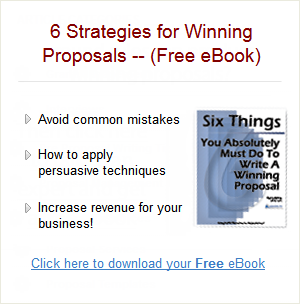Differentiate Yourself From the Competition—Another Look
In a past article, I wrote about the importance of sizing up the competition and discovering ways to differentiate yourself from them. Well, it’s more important now than ever. Why? Because the competition is stiffer, more firms are competing for the same work, and there is often little or no perceptible differences between the firms writing proposals.
This last is critical. It’s essential that you realize a basic truth about how the client views all the competitors in a given firm. From her perspective, all the firms going after a job have basically the same capabilities. In other words, from your client’s point of view, you’re all equally qualified to do the job.
| Features/ Capabilities |
||||||||
| Firms | A | B | C | You |
| From the client’s perspective, all the competing firms are equal and look pretty much the same |
Here’s another fact: The client does not buy a product or service because it’s the same has everyone else’s. She will buy a product or service because it is different from what the rest of the firms offer. It’s cheaper or faster or longer lasting or easier to use or . . .you get the picture.
Your job, then, is to come up with ways to help your client see the differences between what you offer and what the competition is selling. Here’s how you can do that.
Identify all the ways you’re different from the competition. The first thing you do is make a list of every thing that the client will think makes you different from the competition. This is the beginning of your list of discriminators.
If your firm has been in the field longer than anyone else, list it. If you are new to the field, list it. If your project manager has an MBA and you know the no other firm’s PM does, list it. If your technical staff has more years of experience in the field, list it. If you have had more work with this client than anyone else in the competition, list it. If you won an award for client service excellence last year, list it.
If your software application has an interface that differs from the competition’s, list it. If your manufacturing plant is located in a different city, state or even country than your client, list it. If your Quality Assurance program is certified by a major buyer that is not your client, list it.
You get the point. You list all the items that could make you different in the eyes of your client from your competition. Don’t worry about whether or not the differences are significant or important; you’ll do that next. For right now, just do a data-dump of your differences.
Now fit your differences into categories. Here’s where you weed out the important discriminators from the ordinary ones. If a discriminator on your list is ordinary (your software applications interface, for example), then put an O (Ordinary) next to it. The ordinary discriminators won’t make the client sit up and take notice.
If a discriminator is something is special, and has the potential for making the client think “Oh, that’s a good point,” then mark it with an exclamation point (!). The fact that your firm has been in the field longer than anyone else is an example of a ! This is a keeper; you have discovered a special feature of your firm or approach that you can leverage into a benefit to the client.
If you see a discriminator that makes you think, “Oh no!”, you’ve found a difference the client may consider a weakness (the fact that you’re new to the field, for example). Put an X next to it; you’re going to have to find out some way offset that perceived weakness in your proposal.
The whole purpose of this exercise is to identify the differences between you and the competition. Only when you do this can you begin to develop a strategy that positions your approach so the client sees a clear differentiation between you and the rest of the field.
The firm that stands out–in a positive way–is the firm that will win. Next issue, we’ll talk about ways to capitalize on the differences you identify.

